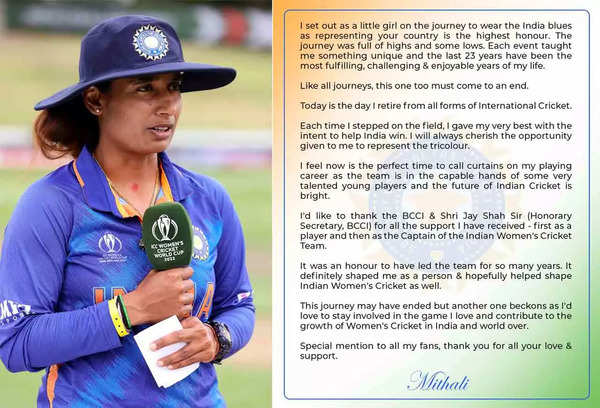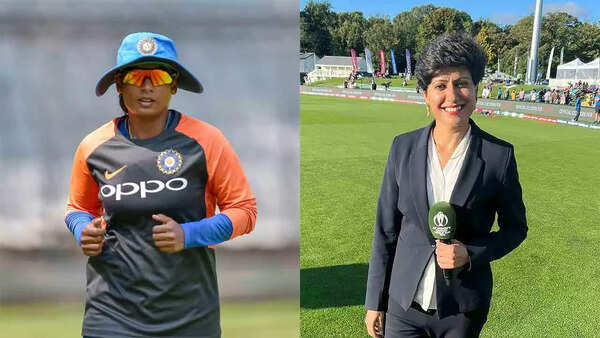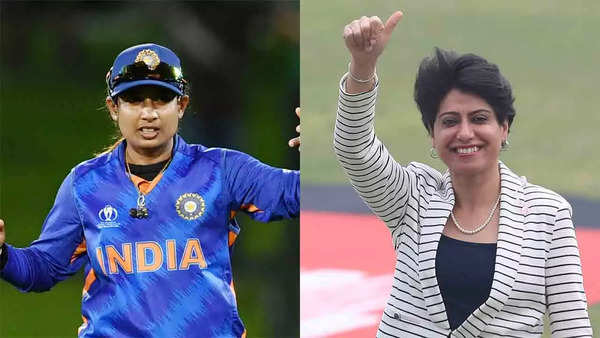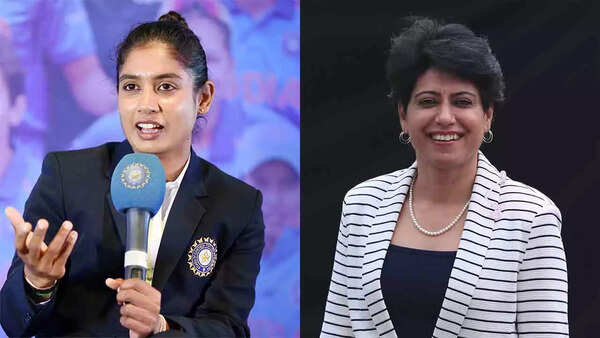
Mithali Raj a catalyst in the growth of Indian women’s cricket, but the writing was on the wall for her, says former India captain Anjum Chopra | Cricket News – Times of India
In an international career dating back to 1999, Mithali played over 300 international matches across all three formats, scoring over 10,000 international runs. She also captained the Indian team for a long time. Mithali was and will always be one of the biggest poster girls of Indian cricket and a trailblazer.
In a freewheeling chat with TimesofIndia.com, Mithali’s former captain Anjum Chopra talks about her memories of playing with Mithali, the timing of Mithali’s retirement announcement, the controversies, the achievements and highlights, Mithali’s captaincy style, what youngsters coming into the team should learn to do and not do and also the tough road that the likes of Mithali, Anjum, Jhulan Goswami, Diana Edulji and other stalwarts of Indian women’s cricket have travelled which has subsequently made things easier for those who are walking into the Indian dressing room today.
As someone who had a long India career and was India captain herself, what would you say is the legacy that Mithali Raj, who also had a long career and was India skipper, has left behind?
The biggest thing is she has seen the transformation (in Indian women’s cricket) from the time she made her debut. Both our debuts were close to each other. Mine was in 1995, her’s was in 1999. From there on, till 2005, when the BCCI took over (Indian women’s cricket) till 2017 when the Indian women’s team played the final for a second time in an ICC event, at the World Cup and then from 2017 to 2022 – the changes that the sport has seen – and to a level where the day Mithali announced her retirement, it was flashed across every National Daily, it was breaking news story for everyone, newspapers carrying an entire page or three fourths of a page just on Mithali, which just shows the growth of the women’s game. And she has been part of that growth. She has been one of the leaders who was one of the catalysts of that growth of women’s cricket. That’s the kind of legacy that she has left behind. For a youngster like a Shafali Verma or a senior player like a Harmanpreet Kaur, they have been part of that journey, but they joined the bandwagon (later), but Mithali has been around from the time when we had very limited access and facilities to today when we have the best of facilities available to a player.

Both your careers overlapped and both of you had long careers playing for India. You saw her grow into a player, playing certain roles which you played for the team. Looking back, which are the memories you remember the most of playing with Mithali?
So many memories (laughs). The best memory I think is obviously playing the 2005 World Cup and in some ways it’s also not the best memory, because we lost in the final to Australia. If you speak to Mithali ask her which is the happier memory for her – winning the semi-final vs New Zealand in 2005 (World Cup) or winning the semi-final vs Australia in England in 2017 (World Cup). For me it’s the 2005 (World Cup final), because it was the first time. Individually we were match winners on different days. One day it was Jhluan (Goswami), another day it was me, another day it was Mithali or Hemlata (Kala) on another day, so we had individual match winners. Also the first Test series that we won as captain and vice-captain – in South Africa in 2002 – and both of us walked out to chase the target of 13. It was my second Test match as captain, it was Mithali’s second Test match as vice-captain and we carried a very young team forward. That team had seven debutants. From there on to partnerships in the middle (with Mithali), saving a Test match or making sure that we win the game, there have been quite a few instances. We have had good chats in the middle – who faces which bowler, how to come out of tough situations and how to utilise the good ones. From the time I retired to where she (Mithali) is today – the best part is where she has left the sport now. What I saw in (media coverage since Mithali announced retirement) – the discussion has been dominated by her retirement more than Rishabh Pant taking over as India captain (for series vs SA after KL Rahul was ruled out) – which is a rarity. I am so happy for Rishabh Pant, I am happy for Harmanpreet (new India women’s team captain) – these are big developments, but (the coverage Mithali got) just shows the growth of the women’s game.

In many ways perhaps you would agree that the writing was on the wall as far as Mithali’s India career was concerned? Her performances had been somewhat below-par compared to the high standards she set for herself over the years. People had begun to ask the question – should Mithali call time on her career? Your take on the timing of Mithali’s decision to bring the curtain down on her international career…
As players we all understand from the time we start playing that the first goal is to make it to a domestic team. First I wanted to play for Delhi – I wanted to be in the first 15, then first 11 and then be counted amongst the top players in Delhi. So the gradual progression for any player is to go step by step. You then want to play for India, then be vice-captain, then you want to lead India and then you want to be known as a match winner for India in every situation. For Mithali, she has seen those phases through her career and she has been a stalwart – scoring more than 10,000 runs in international cricket. I think for a player who has had such a long career there is never a right time to call it quits, because you always feel you can contribute more. You are consistently going from one level to another. And let’s not forget, for any player who has had such a long career and crossed so many milestones – you are always targeting the World Cup – I must have a World Cup trophy, I must win a World Cup for my team. That’s the kind of goal you keep setting for yourself. I am sure Mithali too would be thinking like that. For any player the time to call it quits is very difficult to decide. But, yes, I do agree that the writing was on the wall. If it wasn’t for the pandemic, we might have seen this earlier, we don’t know. But I do know for a fact that the writing was definitely on the wall and it would have been very strange if a team was selected without her being captain or without her in the squad, that would have been odd. At the same time I must praise the selectors on the process – it was smooth and transparent.
Congratulations @M_Raj03 on your remarkable career! Our partnerships on the field are the memories I will cherish… https://t.co/yW1SYePnJR
— Anjum Chopra (@chopraanjum) 1654688208000
There has been a lot of talk over the years of Mithali being a calm and composed person and how she brought that same demeanour into her captaincy on the field as well. We all remember images of her reading a book during the 2017 World Cup match vs England, while waiting to come out to bat. As someone who saw Mithali from very close quarters over the years, your take on the captain that she was…
She has been a quiet person, she has been a reserved person right through her career. Reading a book is probably one of those ways of concentrating and being in her own zone, everyone has their own methods. When you have a long career you devise methods to stay focussed or to stay away from pressure situations, because you want to be in a zone with yourself. You don’t want to be overawed by either a very happy or a very tense situation on the ground. As a batter before approaching an innings you want to be in a space where you can go out and watch the ball and hit the ball and not over analyse situations. Everyone has their own ways. I will say that Mithali has been a player who has been more reserved rather than open. As someone who has seen her from close quarters I know that has reflected on her captaincy. It has been both good and not so good, but that’s what Mithali Raj has been as a batter and as a captain – she has not been very vocal, she has not been very aggressive, she has never been very animated – never has she been like that. It’s every player’s own methodology of playing the game.
Like you said Mithali’s core personality reflected in her captaincy, just like it is for any other player. As a captain one of the biggest responsibilities, if not the biggest, is player management – how you manage the players around you, those already in the squad, those who are knocking on the doors and interacting with you. There have of course also been reports in the past of Mithali not having good relations with one or two senior players and subsequently also of the issues being resolved. Your take on how Mithali, a huge poster girl and stalwart of Indian cricket, led the team, despite being a reserved person, and how that made a few people question certain things from the outside
Being a reserved person and leading a national side that’s for everyone to see and analyse. As a batter you may be reserved, but as a leader, we know that a leader cannot be reserved, we know that as a leader you have to be a little more vocal and make sure that you are interacting with everyone. Now, in the Indian team, it was a mixed bag. Over the last few years there was no certainty of a core team being very consistent. There were players coming in, players going out. Mithali was idolised, because whenever a youngster walks into the team, they will idolise Mithali Raj, they will idolise Jhulan Goswami because they are seniors and have achieved a lot. Whenever there was friction, that had to be addressed and sorted out. To say whether under Mithali’s leadership these were addressed or not – I guess there were other factors as well that needed to be identified and other external factors also which played a part. To say whether Mithali’s captaincy was complete or incomplete will probably be an incomplete statement. The better thing to do would be to pick up an (individual) situation and analysing why did that actually happen – could it have been avoided, could it have been handled better – yes is the answer, but sometimes things don’t just happen in isolation – with just the captain leading from the front, they happen because of other people around as well. However I don’t dilute the fact that a captain can handle that situation better – yes it could have been done. But that’s where everyone’s individual functionality comes into being – how one handles a situation like that, how much an individual involves oneself in that kind of a situation. It’s very individualistic. The kind of person I am, I like to take the bull by its horns – as to what’s the problem? – and sort it out right there and then. But then everyone has their own methods of ways of operating. She also has always had those, like every other captain. And yes, that reflected in her captaincy, it reflected in the team results as well. She has had a long career, it’s commendable.
Thank you for all your love & support over the years!I look forward to my 2nd innings with your blessing and suppo… https://t.co/TkBLwZ2V3m
— Mithali Raj (@M_Raj03) 1654677380000
I have talked to you earlier as well about the 2002 one-off Test in South Africa and you just talked about how Mithali and you went out to bat together to chase down the target. Now, in 2002 – that crop of Indian female cricketers did not really have too many idols to look up to as such. You were in many ways making history and setting the path for youngsters to follow. Today, when you talk about someone like Shafali, who has been playing for a while now for India – she has idols to look up to, she has role models to follow. Cricketers like Mithali and yourself have been trailblazers in that respect. How much would you say has Indian women’s cricket changed from say the mid to late nineties to now and would you say that in many ways it’s easier for the youngsters coming into Indian cricket now, because they have the Anjums, Jhulans and Mithalis to look up to?
It’s definitely easier. You mentioned Shafali Verma walking into the Indian dressing room – how many times in the past has an Indian female cricketer walked into an MCG dressing room and walked out to bat from that tunnel? Never. I remember playing in Sydney – I played the entire World Cup and not a single game was played at the Sydney cricket ground (SCG). There was a series preceding the 2009 World Cup in which we played one game at the SCG – in 2008. Today if you say the women’s team is traveling to England, they will play at Lord’s, if they are travelling to Australia they will play at Adelaide. For women cricketers the toughest road has already been travelled and it was travelled even before I got into the Indian team. Our predecessors deserve a lot of credit for that – they made sure the game stayed alive. Whether it was a Diana Edulji or a Sandhya Agarwal – they ensured that they were there in different phases for the game to remain alive – for us to say there is an Indian women’s cricket team. These women might not be stars, but we love the sport and we will go and be a part of that. And then the journey started. Mithali has been part of that same journey. From where she has left, the next player who walks in – like a Simran Bahadur who walks into the team – she will not have to struggle like a Mithali or Anjum or Diana or Shantha (Rangaswamy) would have struggled for the last 20-25 years. She will straight away walk into a proper, structured road, with well-lit surroundings. It’s not a bumpy road, it’s a smooth ride. It’s up to you whether you drive following the traffic rules or breaking them, but there’s a road which is well laid for you. So it’s easy now for the present lot to idolise Mithali or Jhulan or maybe look at male cricketers and say – fine we have such role models and we want to base our game looking at a Hardik Pandya or a Rishabh Pant or a Virender Sehwag or a MS Dhoni – so it’s much easier. But it will always be up to the individual – the kind of effort that you put in. You still have to learn to defend a ball like it was done 20 years back and you still have to learn to hit a drive the way it has always been hit. So it might be a smoother road but the basics of the game haven’t changed.
The one thing that I want the current lot of cricketers who are coming in to do is to take positive lessons from what Mithali or Jhulan or Harmanpreet (Kaur) have done. It’s absolutely imperative to learn from this lot. What to do and what not to do. It’s absolutely essential. Watching someone on TV and learning cricket is a great art, but when they are in the dressing room as young players, they must look up to such players and when such players walk back into the dressing room (in the future as coach etc) they should be well respected as well so it’s both ways. Today’s newspaper will be history tomorrow and the following week there will be more breaking news, but that legacy that they (great players) leave should be carried forward and the respect that they walk out with should be the same as the one given when they walk back into the dressing room in whatever capacity in the near future.

The immediate period after announcing retirement is in many ways the toughest phase to get through, especially for those who have had long careers. Going from Indian cricketer to former Indian cricketer. It’s very difficult to completely extricate oneself from something that you are so very passionate about. If there was some advice you had to give Mithali right now what would that be?
See you have to enjoy this period as well. First you have to let it sink in that you are not going to be walking into a dressing room anymore. You will be walking into the ground just as a viewer or in another capacity. Number two – it doesn’t happen overnight – the good and not so good memories keep coming back. Some bitter and some sweet memories keep coming back – they don’t fade away and let’s be honest – the bitter memories come before the sweet ones. It will take time. With so much of cricket happening, you will see scores of the women’s cricket team every time you pick up a newspaper. You will be asked (for comments), you will be followed for your reactions (on the Indian cricket teams performances etc) – because she is the latest person to exit the dressing room. It also depends on what she wants to do. For me whatever I am doing now I was already doing before I left the sport so for me my profile didn’t change much, it’s just the time that I was devoting to these activities increased. For Mithali – she has a corporate job, but as a player I am sure they don’t go very regularly to their office. Whether she wants to go to an office and work or whether she wants to pursue activities related to the sport, that’s something that she will decide. There are certain obvious likes and dislikes that you pick up. Your habits change, your system tells you to focus on reading or traveling. But it will take time to realise that you don’t need to pack and unpack your kit bag, you don’t need to take care of your cricketing gear. You can give away your spikes, you can give away your leg guards. The bat you might want to keep, because each time you walk back onto the ground you might want to hit a few balls, but that will slowly go away, because you realise that once you start knocking (a cricket ball) and hitting a few balls, after some time your forearms and your hamstrings hurt – the muscle memory goes away and you realise you are no longer an active player – that you should just pick up the bat and say that it’s a nice piece of wood and not do anything with it. It’s obviously going to be a difficult phase because she’s not 20-25 year old. What she tries to do and what she wants to do in the next phase of being a former sports person is what she needs to decide. That will help her cope with the vacuum that is created of you not going to the nets anymore.

Stay connected with us on social media platform for instant update click here to join our Twitter, & Facebook
We are now on Telegram. Click here to join our channel (@TechiUpdate) and stay updated with the latest Technology headlines.
For all the latest Sports News Click Here
For the latest news and updates, follow us on Google News.

